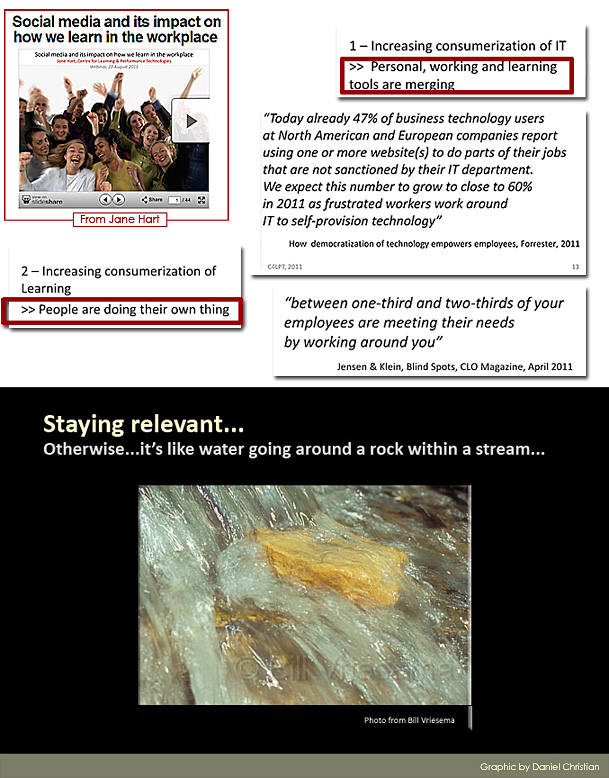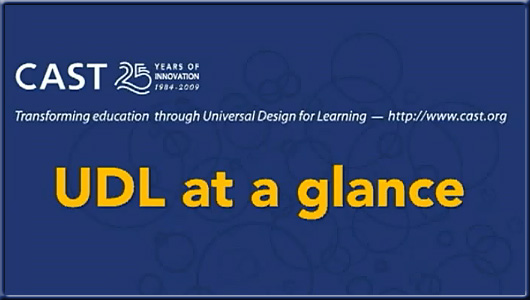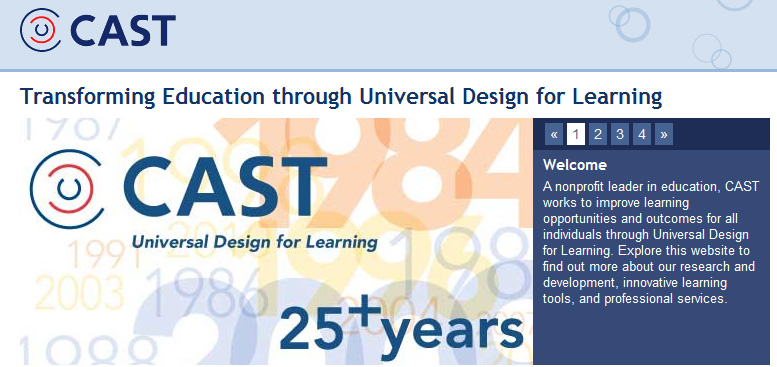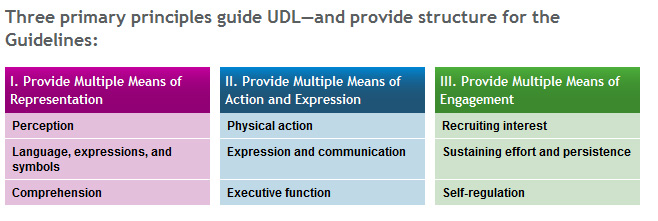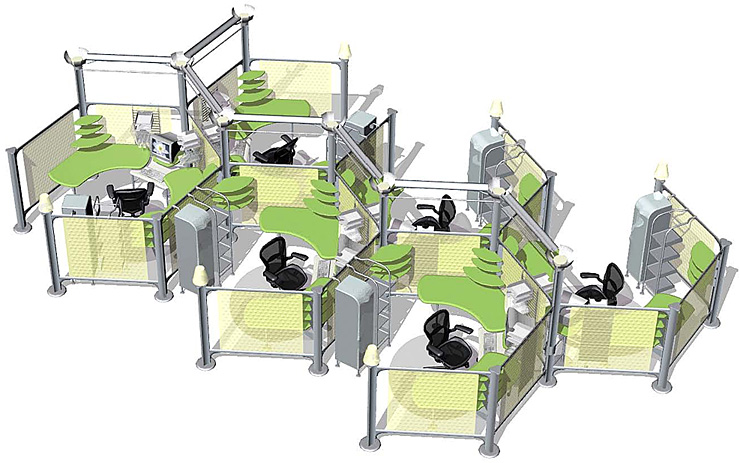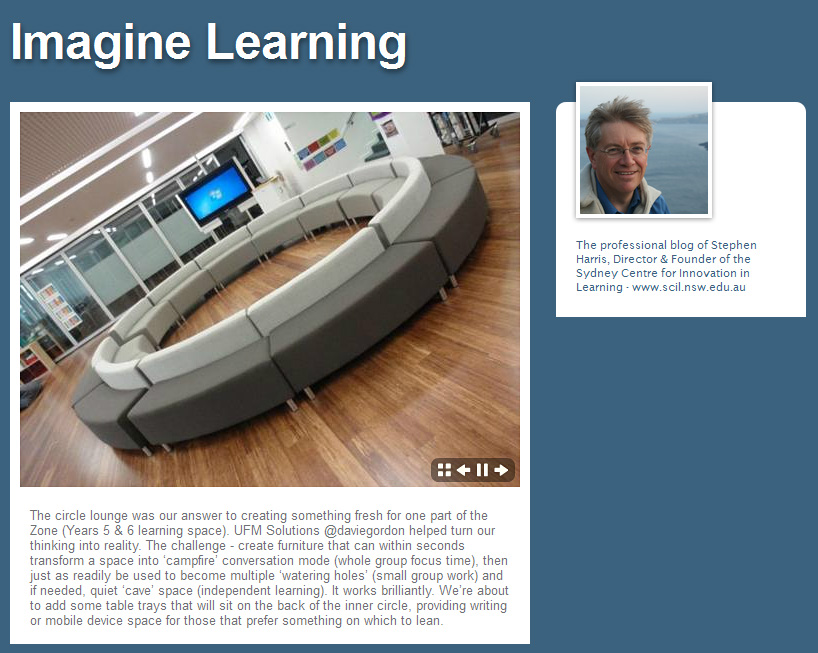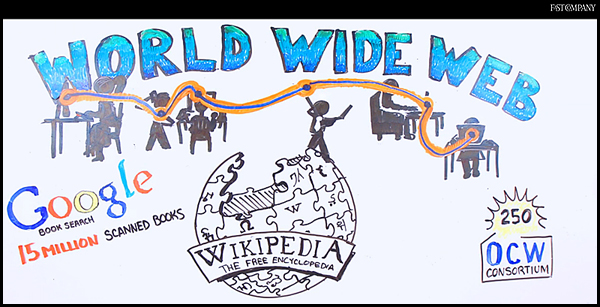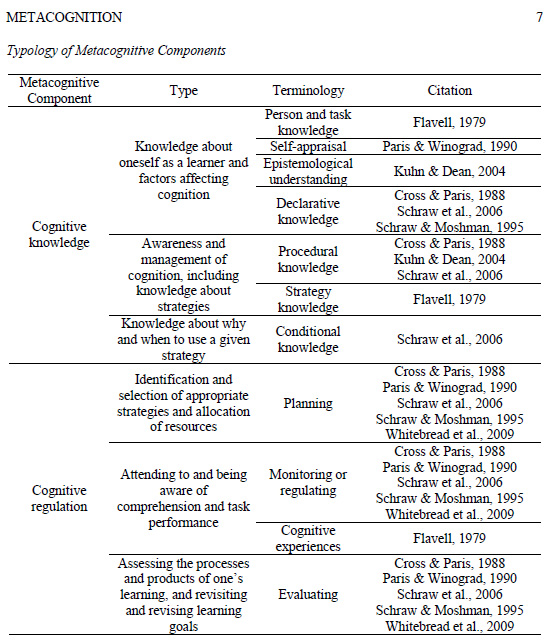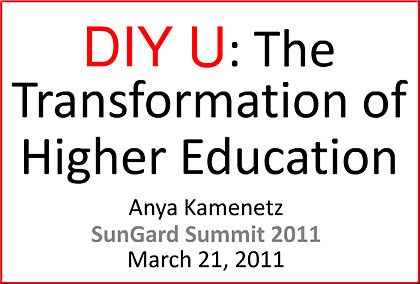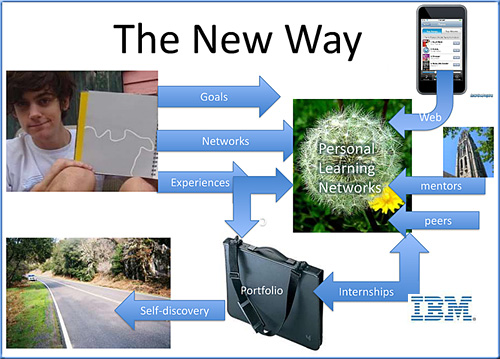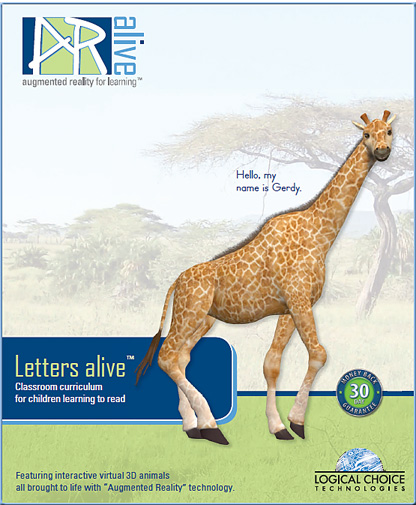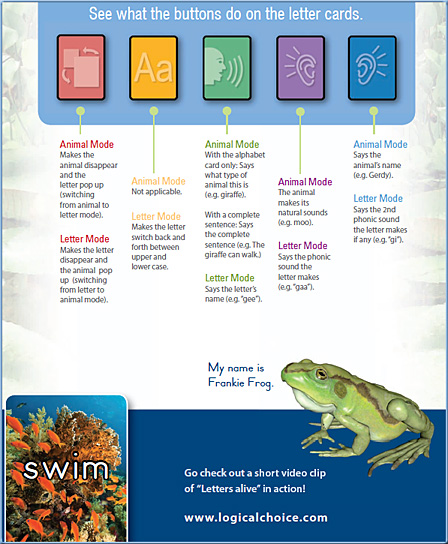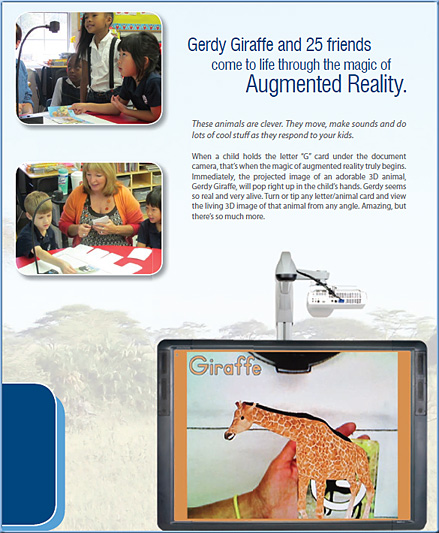Social media and its impact on how we learn in the workplace — from C4PLT by Jane Hart
From DSC:
One reflection that jumped out at me from Jane’s excellent presentation…and that I believe is a universal truth:
If an organization doesn’t respond to changing conditions, needs, desires, preferences, best interests, and/or the requirements of its customers, that organization will diminish in usefulness and will most likely (albeit eventually) go out of business.
I know I’m not introducing a new thought here and the above statement seems very self-evident, but do we heed this advice in corporate L&D? Corporate IT? IT within higher education? In higher education as an industry?
My thanks to Mrs. Krista Spahr, Calvin College, for this resource and the quote below:
Universal Design for Learning (UDL) is meant to minimize barriers and to maximize learning.
…
Reflections from DSC:
Though I still have much to learn about Universal Design for Learning (UDL), my initial thought is that I really like this approach, as it moves us away from the one-size-fits-all approach and towards a teaching and learning environment that offers more choice, more selection, and more opportunities for customization and personalization. Plus, as companies such as Apple and Microsoft have seen, functionality that started out trying to address accessibility-related needs ended up helping everyone!
Along these lines, I created this graphic years ago — with the idea that students would have a choice on which media they might prefer to use to absorb the information:
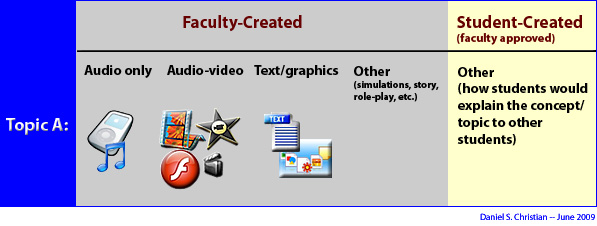
Again, the idea being that we could provide the same content in 3-5 different ways and let the students select what works best for them. Plus, in the example above, we could even see how other students are describing/making meaning of something.
But it goes further than this as I’m understanding UDL. For example, the methods for achieving a learning outcome can be greatly varied, as the assignments for a particular outcome might be reaching via watching a video clip, or reading a book, or doing a project, or writing a story, or creating music, or ___(fill in the blank) ____.
Also see:
‘Narrate, curate, share’: How blogging can catalyze learning — from campustechhnology.com by W. Gardner Campbell
Excerpt:
What is blogging? Is it like an online journal? If so, how is a public journal of academic value? Should I give my students prompts? Will they think this is merely busy work? Should their blogs be about work done in specific classes, work done in several classes, work done outside of class, or all of the above?
Teaching secrets: Teaching students how to learn — from Edweek.org by Cossondra George
Excerpt:
Awareness of common pitfalls and effective strategies can support your efforts to help students “learn to learn” throughout the school year…
From DSC:
I sure wish instructional designers, subject matter experts, professors and teachers could annotate their “books” to give concrete, practical ideas and strategies that would help students to better study, understand, and remember the relevant materials. My early take on this might be achieved via a multi-layered, digital textbook approach that would hopefully address metacognition and help students learn how to learn:

New ways of learning effects library design — Aaron Cohen Associates
Excerpt:
Technology has impacted the way we use library collections. It has impacted the way we interact in the library building. The landscape of learning has changed so much that we need to ask – “Is someone literate if they can not use digital technology?”
Watch the full episode. See more Digital Media – New Learners Of The 21st Century.
DIY U: The Future Of Learning [Video] — from FastCompany.com by Anya Kamenetz
From Khan Academy and TED Talks to instructional YouTube videos, the future of learning is open and free.
A related comment from DSC:
I have it that higher ed is a bubble and if an increasingly larger group of people can’t afford it — yet still want it — then, in my book, that’s a major problem.
I’ll use myself as an example. My wife and I could not begin to afford to send our kids to many of the colleges and universities out there right now — today, in 2011! (Let alone in 2017+ when our kids start hitting the college scene.) I should note that our kids are doing well in school and are very talented, hard workers. I should also point out that my wife and I place a very high value on being educated and we are both trying to pass that value along to the next generation.
But if you tell me that higher ed is not a bubble, the first question I will ask you (besides what planet are you living on) is what’s the gross income for your household? If you are making close to 6 figures, I highly doubt that your perspective will be the same as that of folks from households who are making $20,000-$50,000 a year. In fact, my hunch is that those who say higher ed is not a bubble are:
- Upper middle class to upper class (i.e. wealthy in the eyes of many in the world today)
- Folks who don’t have to worry about where their next paycheck is coming from (nor have they had to live like that in years!); that is, they are doing quite well these days…living quite comfortably
- College educated (nothing wrong with that!)
- Potentially involved with higher ed — or at least want to maintain the status quo
- Folks who do not have children
My take on this is that all of us in higher education need to figure out how we can greatly reduce the price of higher education. It shouldn’t be how well you understand the system or how many hours of work you have done to figure out the grants, loans, etc. that exist out there.
NEVER again should we be pleased with ANY sort of increase in tuition. Never again should we say, “Well, our tuition only went up by ___% which is the smallest increase in our history (or the smallest increase relative to our competition…or the smallest in our state/country/nation).”
Such a situation is causing a backlash against the current higher education environment/setup.
As such, we need to constantly be looking to reinvent ourselves — and to staying relevant.
Addendum on 6/17/11:
- Colleges add net price calculators to school prospective students on degree costs –– ecampusnews.com
New tool will give students a more accurate cost estimate
So many learning style tests, so little time… — from Lasagna and Chips by Joitske Hulsebosch
Excerpt (emphasis DSC):
I’m amazed that there are so many different learning style theories and tests! The families definitely help to choose what you’d want to work with if you are looking for a learning style test. I’d prefer a style test that acknowledges the dynamic nature of preferences. It may depend on the situation and what you want to learn what your preferences are. And I don’t believe in the auditory/visual/kinesthetic learner difference.
I still think the tests are helpful for learners to become self-aware. You can use it as a starting point to reflect about yourself and think for instance about your pitfalls and strengths as facilitator. Or as a learner- what activities work for you? Do you thrive on certain ways of learning? How to strengthen this? The downside is of course that you fill in the tests yourself (rubbish in- rubbish out!), so some feedback from others may be needed too.
From DSC:
I like how Joitske mentioned the word preferences a lot. With all the disagreement whether learning styles exist or not, I do believe people prefer to absorb/learn the required materials in certain formats. Certain manners of taking information in are more enjoyable, easier, or to me, more efficient. I can learn the information most of the ways it might be presented, but I prefer visuals…not all text, as an example. This idea is closely related to developing a love of learning (or conversely, a hatred towards learning).
Metacognition: A Literature Review Research Report — from Pearson by Emily Lai, April 2011
Abstract
Metacognition is defined most simply as “thinking about thinking.” Metacognition consists of two components: knowledge and regulation. Metacognitive knowledge includes knowledge about oneself as a learner and the factors that might impact performance, knowledge about strategies, and knowledge about when and why to use strategies. Metacognitive regulation is the monitoring of one’s cognition and includes planning activities, awareness of comprehension and task performance, and evaluation of the efficacy of monitoring processes and strategies. Recent research suggests that young children are capable of rudimentary forms of metacognitive thought, particularly after the age of 3. Although individual developmental models vary, most postulate massive improvements in metacognition during the first 6 years of life. Metacognition also improves with appropriate instruction, with empirical evidence supporting the notion that students can be taught to reflect on their own thinking. Assessment of metacognition is challenging for a number of reasons: (a) metacognition is a complex construct; (b) it is not directly observable; (c) it may be confounded with both verbal ability and working memory capacity; and (d) existing measures tend to be narrow in focus and decontextualized from in-school learning. Recommendations for teaching and assessing metacognition are made.
Keywords: metacognition, self-regulated learning
From DSC:
Also see Chapter 12 of:
- Ormrod, J. E. (2008). Human learning (5th ed.). Upper Saddle River, NJ: Pearson. ISBN 9780132327497.
…which has excellent further resources, additional literature reviews, learning strategies.
Learning & Skills Survey: 87% More eLearning & Mobile Learning; 73% Less 2-3 Day Classroom Training — from the Upside Learning blog by Amit Garg
If you want to truly engage students, give up the reins — from Ewan McIntosh
During the final half of 2010, I asked more than 1,500 teachers around the globe two questions: what are your happiest memories from learning at school, and what are your least happy experiences?
When I do the “reveal” of what I think their answers will be, every workshop has a “but how did he know?” reaction. It’s more akin to an audience’s response to illusionist Derren Brown than to the beginning of a day of professional development.
For teachers’ answers are always the same. At the top is “making stuff”, then school trips, “feeling I’m making a contribution” and “following my own ideas”. Their least happy experiences are “a frustration at not understanding things”, “not having any help on hand” and “being bored”, mostly by “dull presentations”. “Not seeing why we had to do certain tasks” appeared in every continent.
Most of these educators agreed that the positive experiences they loved about school were too few, and were outnumbered by the “important but dull” parts of today’s schooling: delivering content, preparing for and doing exams.
But while a third of teachers generally remember “making stuff” as their most memorable and happy experience at school, we see few curricula where “making stuff” and letting students “follow their own ideas” makes up at least a third of the planned activity.









